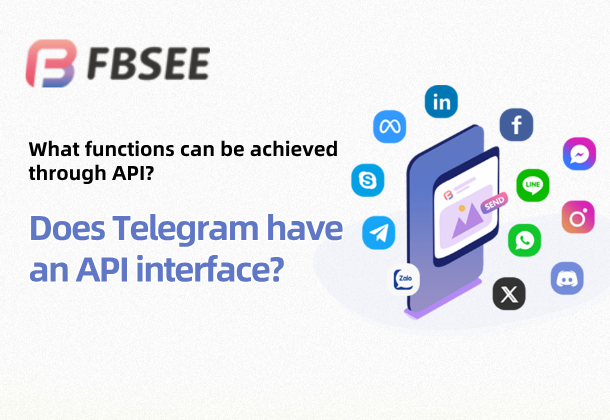Does Telegram have an API? Can it be connected to CRM or other marketing tools?
As the user scale of Telegram continues to expand, more and more companies and businesses are starting to use the Telegram platform for customer communication, marketing promotion, and community management. One of the most common questions companies encounter during Telegram operations is: Does Telegram provide an API interface that can be connected to CRM, marketing automation tools, or internal corporate systems? Behind this question is the core demand of companies to achieve unified management of customer data, efficient marketing, and improved service efficiency.
In fact, Telegram does provide an API interface for developers. However, the main purpose of this interface is not entirely for enterprise customer management or CRM docking, but mainly for developing robots (Bot), sending messages or performing basic interactions. If enterprises want to directly synchronize data with CRM or other marketing tools through the native Telegram API interface, they often need to carry out complex technical development and face great challenges.
So, for ordinary corporate users, is there a simpler and more efficient way to achieve data interoperability between Telegram and CRM and marketing systems?
👉Telegram multi-account/group control/counting/following/accepting fans/translation/cross-border customer service software: https://fbsee.com/en
😊For free trial, please contact TELEGRAM✈official customer service: @Fbsee
The real status of Telegram's official API interface
The API interfaces officially provided by Telegram mainly include two forms:
The first is the Telegram Bot API , which is mainly used to create robots and use them to implement scenarios such as automated message sending, basic question-and-answer processing, and simple interactions. Through this type of API, companies can achieve basic customer service automation on Telegram, but there are still obvious limitations: data cannot be directly synchronized to CRM and ERP systems; the types of interactions are limited and cannot meet personalized and refined customer management needs.
The other is the Telegram client API (MTProto API), which is used to develop third-party clients or customized applications. Although this interface is more flexible, it has a higher development threshold and requires support from a professional technical team. It has a high cost and cycle, and is not suitable for general enterprises to quickly get started.
Therefore, it may not be the best choice for companies to rely solely on Telegram's official API to synchronize data and connect with marketing systems.
Why do companies urgently need to connect Telegram with CRM or marketing tools?
When companies use Telegram to communicate with customers, they often face the following challenges:
The first is the problem of fragmented customer data . Many companies’ customer communication channels are not just Telegram, but may also involve multiple social platforms such as WhatsApp, LINE, and Facebook. If data cannot be managed in a unified manner, it will create information islands, making it difficult for companies to conduct complete customer portrait analysis.
The second is the efficiency issue . If customer service staff have to manually copy Telegram customer information, chat records, etc. to the CRM system or marketing automation tool every time, it will inevitably greatly reduce customer service efficiency and even affect customer satisfaction.
Finally, there is the issue of data accuracy . Manually input data is prone to errors and duplications, and it is difficult for companies to ensure the accuracy of customer data, which will have a negative impact on precision marketing, customer retention, and repeat purchase marketing.
Therefore, companies are eager to achieve automatic synchronization of data between Telegram and CRM or other marketing tools to form an efficient and accurate marketing closed loop.
How can third-party tools help companies achieve seamless integration of Telegram and CRM systems?
In order to overcome the shortcomings of Telegram's native API interface, third-party aggregation tools came into being. Among them, the FBsee customer service system that focuses on cross-platform social account management is the most representative.
FBsee can centrally manage customer communication information on global mainstream social platforms such as Telegram, WhatsApp, Zalo, and LINE, and provide convenient standardized data interfaces to easily connect to mainstream CRM systems (such as Salesforce, HubSpot, and Zoho) or marketing automation platforms. With simple configuration, enterprises can easily achieve automatic synchronization, real-time sharing, and intelligent management of customer data, completely eliminating the tedious process of developing interfaces on their own.
Specifically, the Telegram data docking function provided by FBsee has the following core advantages:
1. Code-free API docking: Enterprises do not need a professional technical team or complex development. Through FBsee's built-in API, they can easily complete the real-time synchronization of Telegram customer data with CRM, ERP, and marketing tools, greatly reducing the technical threshold and operating costs of enterprises.
2. Unified management across platforms FBsee customer service system can unify the management of Telegram and other mainstream social platforms. Enterprises can manage customer data from multiple channels simultaneously in one background, solving the problem of data fragmentation.
3. Intelligent synchronization of customer tags and notes FBsee allows enterprises to classify Telegram customers with tags, make notes, and automatically synchronize this information to external CRM systems. In this way, the customer service team can share customer interaction records in real time, quickly understand customer needs, and achieve precise customer maintenance and marketing.
4. Real-time interactive data push The interactive information of enterprises on Telegram, such as customer inquiries, purchase consultations, and historical chat records, can be automatically pushed to the CRM system or marketing automation platform in real time, making customer communication more accurate and efficient.
Case analysis: The actual effect of enterprises using Telegram to connect to the CRM system
Let's take a cross-border e-commerce company as an example. The company uses Telegram to communicate with global customers and has a large number of customer inquiries to handle on a daily basis. Before connecting to FBsee, the customer service team needed to manually record customer information and spent a lot of time sorting out data every day, which was inefficient and easy to miss important customers.
After connecting to the FBsee customer service system, the company quickly completed the automatic connection between Telegram customer data and the company's CRM (such as HubSpot), and customer tags and chat interaction status were updated to the CRM in real time. The customer service team can view the customer's historical communication records at any time, greatly reducing repeated consultations and ineffective communication. At the same time, the CRM backend can automatically trigger marketing follow-ups such as emails, text messages, or WhatsApp based on customer interaction data, achieving precise marketing and efficient conversion.
After achieving data interoperability between Telegram and CRM through FBsee, the company's customer service efficiency increased by more than 50%, customer satisfaction improved significantly, and overall performance and customer conversion rates also improved significantly.
Conclusion: FBsee enables Telegram and CRM to achieve true data interoperability
Although Telegram officially provides some API interfaces, these interfaces cannot fully meet the needs of enterprise customer data docking. Through third-party professional tools such as FBsee customer service system, enterprises can easily achieve real-time synchronization of Telegram customer data with CRM and marketing automation platforms, fundamentally solving problems such as customer data fragmentation, low management efficiency, and inaccurate marketing.
If you are also facing the problem of connecting Telegram customer data, you might as well try FBsee as soon as possible. It can realize data interoperability in the simplest way, making corporate customer service management and marketing more efficient and accurate!







